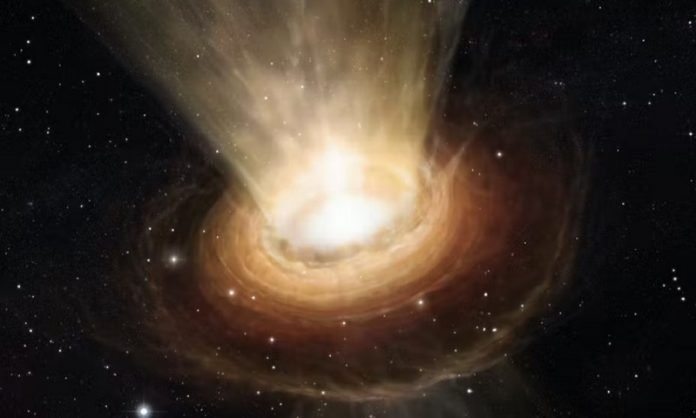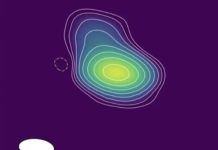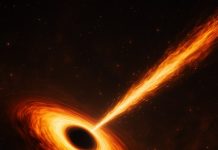
During the first billion years of the universe, winds blown by supermassive black holes at the centers of galaxies were much more frequent and more powerful than those observed in today’s galaxies, some 13 billion years later.
Such winds were so mighty that they slowed down the growth of the supermassive black holes from which they originate.
These are the results of a study led by three researchers from the Italian National Institute for Astrophysics (INAF) in Trieste, published in the journal Nature.
The work is based on the observations of 30 quasars observed with the Very Large Telescope (VLT) at ESO’s Paranal Observatory in Chile.
Quasars are extremely bright, point-like sources at the cores of distant galaxies, whose emission arises from the intense activity of the central supermassive black holes sucking in the surrounding matter.
The host galaxies of these quasars were observed around cosmic dawn, when the universe was between 500 million and 1 billion years old.
“For the first time, we measured the fraction of quasars in the young universe exhibiting black hole winds,” says Manuela Bischetti, INAF researcher in Trieste and first author of the new study.
“Unlike what we observe in the universe closer to us, we discovered that black hole winds in the young universe are very frequent, have high speeds up to 17 percent of the speed of light, and inject large amounts of energy into their host galaxy.”
About half of the quasars observed in this research show black hole winds, which are much more frequent and 20 times more powerful than the ones known in the quasars of the more nearby cosmos when the universe was around 4 billion years old.
“Observations of black holes in the young universe show that they grow much faster than their host galaxies, whereas in the local universe, we know that black holes and galaxies co-evolve,” adds co-author Chiara Feruglio, INAF researcher in Trieste.
“This implies that a mechanism must have acted at some point in the universe, slowing down black hole growth. Our observations enabled us to identify this mechanism in the black hole winds produced when the universe was 0.5 to 1 billion years old.”
The energy injected by winds would have been thus able to halt further matter accretion onto the black hole, slowing down its growth and kicking off a “common evolution” phase between the black hole and its host galaxy.
“This study allowed us to identify the epoch in the history of the universe during which the impact of black hole winds started being significant,” adds Bischetti.
“This has a huge impact on our knowledge of the initial phases of growth of black holes and their host galaxies, setting strong constraints on the models that describe the formation of the first galaxies.”
A totally unexpected discovery, it was made possible by the high-quality data from the Xshooter instrument installed on the VLT in the context of a large ESO program with around 250 hours of observations.
“Quasars are among the brightest objects observable in the early universe, but due to their distance, they are quite faint in terms of observed magnitude,” explains co-author Valentina D’Odorico from INAF in Trieste, affiliated to Scuola Normale Superiore in Pisa and principal investigator of the observing program the study is based upon.
“The large investment of time dedicated to observing these objects and the unique capacities of X-shooter in terms of efficiency, wavelength coverage and resolving power have allowed us to obtain very good quality spectra which enabled this interesting result.”
“We’ve had indications for a few years that black holes 1 billion times more massive than the sun… could launch powerful winds that travel at a speed equal to 20 percent of the speed of light into their surroundings,” adds Andrea Ferrara, professor at the Scuola Normale Superiore (SNS) and co-author of the study.
“Today, we have confirmation of this thanks to data obtained with a European telescope by a team with a strong Italian imprint and leadership. The SNS has contributed on the theoretical interpretation side.
The discovery of these spectacular galactic winds at such remote times could have had enormous and as yet unexplored implications for the birth and evolution of galaxies like ours. We will address these questions in the ongoing continuation of this study.”
The program had not been originally designed for this scientific goal, but to study primarily intergalactic gas in the early universe. On the basis of information from more nearby quasars, such winds were thought to be rare.
“Luckily, we used to say, because these features complicate reconstructing the intrinsic quasar emission, they were unwanted by astronomers in our collaboration who study the intergalactic medium along the line of sight,” says D’Odorico.
“Unexpectedly, we found these winds to be very common in the young universe, which complicated our analysis but offered us the opportunity to discover a very important result.”
Written by Italian National Institute for Astrophysics.



